
The Zama appraisal program will take place in 2018-2019, and Pemex plans to spud Asab-1 in the third quarter of 2018. (Source: Premier Oil’s May 2018 investor presentation)
For the past several years, the American Association of Petroleum Geologists has offered the Discovery Thinking Forum as part of its annual meeting. These presentations always offer a fascinating insight into the work that goes into a prospect before a rig ever moves onsite.
Following this year’s theme, “Awakening Sleeping Giants,” John Parker, executive vice president of exploration for Talos Energy, gave a presentation about that company’s Zama-1 discovery, drilled in 2017 by Talos and partners Premier Oil Plc and Sierra Oil & Gas.
The opening of Mexico’s potential oil and gas fields to international companies might seem like a gift from the gods since many of these areas are hugely underexplored, and Talos jumped at the opportunity to bid in Round 1.1, securing two bids. But developing this area won’t be a picnic.
The well, designed to test a series of stacked Miocene amplitude anomalies, was drilled from May to July 2017.
“The rocks in Mexico are different than the northern Gulf of Mexico,” Parker said. “We realized we weren’t in Kansas anymore.”
With little well control—the nearest wells are several kilometers away—and considerable structural complexity, the prospect forced the partners to chart a challenging course, with Talos being the first international operator to work with the Comisión Nacional de Hidrocarburos (CNH). And the seismic data it had access to were not ideal—a narrow-azimuth 2-D line with low-frequency beam migration data, poor relative amplitude and no angle stacks or gathers. The base maps were also sketchy, with some well locations being plotted up to 30 km (18.6 miles) from their actual location.
Talos worked through these issues by engaging in frequent communication with the CNH and service companies and through advance planning. It also reconstructed the seismic data using available well control. A nearby well had a complete logging suite, so those data were able to be correlated.
The result was beyond imagination. “We were in our war room for three days,” Parker said. “We were drilling pay all of that time.” It is one of the 20 largest shallow-water discoveries globally in the last 20 years, he added.
Talos plans to spud its first Zama appraisal well in the fourth quarter, and recently Pemex has announced plans to spud an appraisal well in an adjacent block in August to test the extent of the discovery.
For Parker, the discovery is a testament to the hard work and optimism needed for any exploration project. “A negative bias is just that,” he said. “You can always find reasons not to drill a well. But successful oil finders have a vision of a discovery in mind, and they focus on compelling reasons to get the well drilled that finds the next giant discovery.”
Recommended Reading
Vår Energi Hits Oil with Ringhorne North
2024-04-17 - Vår Energi’s North Sea discovery de-risks drilling prospects in the area and could be tied back to Balder area infrastructure.
Tethys Oil Releases March Production Results
2024-04-17 - Tethys Oil said the official selling price of its Oman Export Blend oil was $78.75/bbl.
Exxon Mobil Guyana Awards Two Contracts for its Whiptail Project
2024-04-16 - Exxon Mobil Guyana awarded Strohm and TechnipFMC with contracts for its Whiptail Project located offshore in Guyana’s Stabroek Block.
Deepwater Roundup 2024: Offshore Europe, Middle East
2024-04-16 - Part three of Hart Energy’s 2024 Deepwater Roundup takes a look at Europe and the Middle East. Aphrodite, Cyprus’ first offshore project looks to come online in 2027 and Phase 2 of TPAO-operated Sakarya Field looks to come onstream the following year.
E&P Highlights: April 15, 2024
2024-04-15 - Here’s a roundup of the latest E&P headlines, including an ultra-deepwater discovery and new contract awards.





